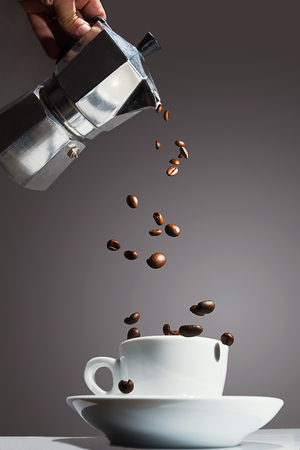1. Introduction to Reusable Coffee Gear
In recent years, the sustainability movement has made significant waves in U.S. coffee culture. More Americans are becoming aware of the environmental impact of single-use plastics and disposable cups, leading to a surge in demand for reusable coffee gear. Whether it’s your favorite local café offering discounts for bringing your own mug, or national chains rolling out eco-friendly initiatives, the shift is clear: sustainable practices are increasingly woven into daily routines. This trend is not just about reducing waste—its about embracing materials that align with a healthier planet and a more conscious lifestyle. As reusable tumblers, mugs, straws, and filters become staples among American coffee lovers, understanding what theyre made of—and why those choices matter—has never been more important.
2. Silicone: Flexibility and Safety
When it comes to reusable coffee gear, silicone is a standout material thanks to its remarkable flexibility, safety, and versatility. Food-grade silicone is a synthetic polymer made from silicon, oxygen, carbon, and hydrogen. Unlike regular plastics, food-grade silicone does not contain harmful chemicals like BPA or phthalates, making it an increasingly popular choice in the American market for eco-conscious consumers.
The Science Behind Food-Grade Silicone
Food-grade silicone is engineered to resist chemical reactions with food or beverages, even at high temperatures. This characteristic means your hot coffee won’t leach unwanted flavors or toxins from the silicone components of your mug or lid. The molecular structure of silicone provides both durability and elasticity—two qualities that make it ideal for collapsible cups, flexible lids, and seals in reusable coffee tumblers.
Key Properties of Food-Grade Silicone
| Property | Description | Benefit for Coffee Gear |
|---|---|---|
| Durability | Resistant to cracking, fading, and brittleness over time | Long-lasting performance despite daily use |
| Temperature Resistance | Tolerates -40°F to 450°F (-40°C to 232°C) | Safe for both hot and cold beverages; suitable for dishwashers and microwaves |
| Chemical Inertness | Does not react with acids or bases in foods or drinks | No off-flavors or contamination risk |
| Flexibility | Bends without breaking or losing shape | Ideal for collapsible designs and leak-proof seals |
Potential Health Impacts
The FDA approves food-grade silicone for use in contact with food and drinks. Research shows that properly manufactured silicone does not release significant amounts of chemicals at temperatures commonly used in food preparation. However, its important for consumers to ensure their coffee gear is labeled as “food-grade” and sourced from reputable brands, as lower-quality silicone may contain fillers or impurities.
In summary, silicone’s unique blend of safety, resilience, and practicality makes it a smart choice for reusable coffee gear—whether you’re commuting in New York City or camping in the Rockies. As long as you choose certified food-grade products, you can enjoy your brew with peace of mind.

3. Stainless Steel: Durability and Performance
Stainless steel has become a cornerstone material in the world of reusable coffee gear, especially among American consumers constantly on the go. This preference is no accident; stainless steel is renowned for its remarkable longevity, often outlasting plastic or glass alternatives by years. Its resistance to rust and corrosion means that your tumbler or travel mug can handle daily commutes, outdoor adventures, and even accidental drops without missing a beat. But durability isn’t the only reason stainless steel stands out.
Another key factor is heat retention. High-quality stainless steel coffee containers—often double-walled and vacuum-insulated—are designed to keep beverages hot (or cold) for hours. This feature aligns perfectly with the American lifestyle, where long drives, busy workdays, or extended meetings make it essential to have coffee at just the right temperature. Many commuters swear by their stainless steel mugs because they can rely on them to deliver a consistent drinking experience throughout the day.
From a health perspective, stainless steel offers peace of mind as well. It doesn’t leach chemicals into your drink, even when exposed to heat or acidic coffee. Cleaning is straightforward too; most stainless steel coffee gear is dishwasher-safe and doesn’t retain odors or flavors from previous brews.
In short, the blend of durability, thermal performance, and safety makes stainless steel a top choice for reusable coffee gear across America. Whether you’re sipping your morning brew on a cross-country road trip or refueling during a hectic workday, it’s easy to see why this material remains a commuter favorite.
4. Bamboo: The Eco-Friendly Choice
When it comes to reusable coffee gear, bamboo is quickly gaining ground as an eco-friendly alternative to plastics and metals. This remarkable material stands out for its sustainability, natural antimicrobial qualities, and versatility in design, making it an ideal choice for environmentally conscious consumers.
Understanding Bamboo as a Renewable Resource
Bamboo is one of the fastest-growing plants on Earth, with some species capable of growing up to three feet per day. Unlike hardwood trees that take decades to mature, bamboo can be harvested in just 3–5 years without replanting, since its root system continually produces new shoots. This rapid renewability makes bamboo a highly sustainable raw material for reusable products.
Bamboo vs. Other Materials: Sustainability Comparison
| Material | Renewability | Harvest Cycle | Environmental Impact |
|---|---|---|---|
| Bamboo | Highly renewable | 3-5 years | Low (minimal pesticides/fertilizers) |
| Stainless Steel | Non-renewable (mined metal) | N/A | Moderate (energy-intensive production) |
| Silicone | Semi-renewable (derived from sand/silica) | N/A | Moderate (chemical processing required) |
| Plastic | Non-renewable (petroleum-based) | N/A | High (non-biodegradable, pollution risk) |
The Antimicrobial Properties of Bamboo
Bamboo naturally contains a bio-agent known as “bamboo kun,” which gives it inherent antimicrobial and antifungal properties. This helps reduce the growth of bacteria on coffee cups, stirrers, and lids made from bamboo—an important health benefit for daily use items. While these properties are most pronounced in untreated bamboo, even processed bamboo fiber retains some of these advantages.
Bamboo’s Role in Sustainable Product Design
Bamboo’s lightweight yet sturdy structure allows designers to create stylish, durable coffee accessories such as travel mugs, cup holders, and reusable straws. Its natural aesthetic fits seamlessly into modern American lifestyles that value both function and environmental responsibility. Plus, bamboo products are typically biodegradable at the end of their lifecycle, unlike most plastics or metals.
5. Other Materials: Glass, Ceramic, and Plastics
When exploring the world of reusable coffee gear, you’ll find that glass, ceramic, and plastics are also popular choices alongside silicone, stainless steel, and bamboo. Each material brings its own set of unique benefits and potential drawbacks, making it important to understand their comparative qualities before making a purchase.
Glass
Glass coffee gear is favored for its clean aesthetic and ability to preserve flavor without imparting any unwanted tastes or odors. It is non-reactive, meaning your brew tastes exactly as intended—no metallic or chemical aftertaste. However, glass can be fragile and may break if dropped or exposed to sudden temperature changes. Borosilicate glass, often used in higher-end products, offers improved durability but still requires careful handling.
Ceramic
Ceramic cups and mugs deliver a classic coffeehouse experience with excellent heat retention and insulation properties. Ceramics generally don’t affect the taste of your beverage and are available in a wide range of designs. While they are sturdier than glass, ceramics can chip or crack when mishandled. They’re also heavier than other materials, which might influence portability for on-the-go use.
Plastics
Plastic components are common in affordable reusable coffee cups and travel mugs thanks to their lightweight nature and resistance to breaking. Many brands now use BPA-free plastics to address health concerns associated with traditional plastics. While they are practical for commuting or outdoor activities, some users report that plastic can absorb flavors over time or retain odors—especially if not cleaned thoroughly. Additionally, plastics may not provide the same level of thermal insulation as double-walled stainless steel or ceramic.
Choosing What Fits Your Lifestyle
The best material for your reusable coffee gear depends largely on how you plan to use it. If you prioritize flavor purity at home, glass or ceramic may be ideal. For commuting or outdoor adventures where durability is key, high-quality plastics or borosilicate glass might suit your needs better. Consider factors like weight, breakability, heat retention, and ease of cleaning when making your decision.
Summary
Ultimately, understanding the pros and cons of glass, ceramic, and plastics empowers you to make informed choices tailored to your daily coffee rituals—whether you’re seeking style, function, sustainability, or convenience.
6. Material Safety and Maintenance Tips
To get the most out of your reusable coffee gear—whether it’s made from silicone, stainless steel, bamboo, or other eco-friendly materials—proper care is essential for both safety and longevity. Here are some practical tips tailored to each material, so you can keep your coffee experience both sustainable and satisfying.
Silicone: Simple Cleaning, Lasting Freshness
Silicone coffee gear is prized for its flexibility and heat resistance. Wash silicone items in warm, soapy water after each use to prevent residue buildup. Most silicone products are also dishwasher safe; just double-check the manufacturer’s instructions. If you notice lingering odors or stains, soak the item in a mixture of baking soda and water overnight. Avoid using sharp utensils that could puncture or degrade the silicone surface over time.
Stainless Steel: Rust-Free Durability
Stainless steel is nearly indestructible but does require regular cleaning to maintain its shine and prevent off-flavors. Hand wash with mild detergent and a soft sponge; avoid abrasive scrubbers that can scratch the surface. For deep cleaning, fill with a solution of vinegar and water, let it sit for 15-20 minutes, then rinse thoroughly. Always dry completely to avoid water spots and potential rusting around seams or lids.
Bamboo: Keep It Dry, Keep It Safe
Bamboo coffee gear adds a natural aesthetic but needs gentle handling. Wash bamboo items by hand with mild soap and lukewarm water—never soak them or put them in the dishwasher, as excessive moisture can cause warping or mold growth. Periodically treat bamboo with food-grade mineral oil to maintain its luster and prevent cracking. Store in a dry place away from direct sunlight.
Plastic and Glass: Everyday Care
If your reusable coffee gear includes BPA-free plastic or glass components, follow these basic steps: Wash plastic by hand or on the top rack of your dishwasher (if labeled dishwasher-safe). Avoid high temperatures that may warp plastic. For glass parts, use non-abrasive sponges to prevent scratches; allow both materials to air dry completely before storing to reduce bacterial growth.
General Longevity & Safety Best Practices
No matter which material you choose, always inspect your coffee gear regularly for signs of wear—cracks in silicone, rust spots on steel, splinters in bamboo, or chips in glass. Replace items that show significant damage to avoid health risks. By following these simple maintenance routines, you’ll ensure your favorite coffee gear remains safe, clean, and ready for your next brew—helping you cut waste while sipping in style.
7. Choosing the Right Coffee Gear for Your Lifestyle
When it comes to picking the perfect reusable coffee cup or mug, there’s more to consider than just your favorite color or brand. The material you choose—whether it’s silicone, stainless steel, bamboo, or another eco-friendly option—can impact everything from convenience and style to your health. Let’s break down what you should think about before making your next coffee gear purchase.
Convenience and Daily Routine
If you’re always on the move, a lightweight and leak-proof design is essential. Stainless steel tumblers offer superior insulation, keeping your coffee hot for hours and surviving the bumps of a busy commute. Silicone cups are collapsible, making them perfect for stashing in your bag after use. Consider how easy the cup is to clean: dishwasher-safe options save time, especially if you use your cup every day.
Aesthetics and Personal Expression
Your coffee gear is also an accessory—a way to express your personality and values. Bamboo mugs bring a natural, earthy vibe that’s Instagram-ready, while sleek stainless steel appeals to minimalists and modernists alike. Many brands offer custom colors and patterns so you can match your gear with your personal style or even support local artists through unique collaborations.
Health Considerations
Material safety matters when it comes to what you drink from daily. Food-grade stainless steel doesn’t leach chemicals and resists stains and odors. Quality silicone is BPA-free and flexible but make sure to select reputable brands to avoid low-grade additives. Bamboo fiber cups are biodegradable but often contain binding resins; check labels for melamine or other synthetics if you’re concerned about chemical exposure at high temperatures.
Eco-Friendly Impact
Think about the life cycle of your cup: How sustainable are the materials? Bamboo grows quickly with minimal resources, while stainless steel can be recycled almost endlessly. Opting for high-quality gear means less waste over time as these products last longer and need less frequent replacement.
Finding Your Perfect Match
The best reusable coffee cup is one that fits seamlessly into your life—supporting both your habits and your values. Whether you prioritize insulation, weight, design, or safety, understanding the strengths of each material helps ensure that your daily brew supports not only your taste buds but also your health and the planet.


